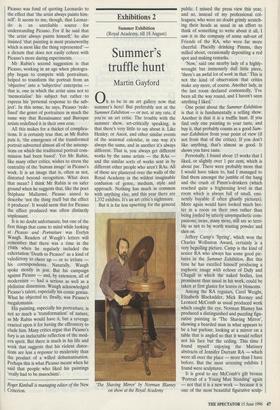Exhibitions 2
Summer Exhibition (Royal Academy, till 18 August)
Summer's truffle hunt
Martin Gayford
Oh to be in an art gallery now that summer's here! But preferably not at the Summer Exhibition — or not, at any rate, if you're an art critic. The trouble with the summer show, art-critically speaking, is that there's very little to say about it. Like Henley, or Ascot, and other similar events of the seasonal calendar, in one way it's always the same, and in another it's always different. That is, you always get different works by the same artists — the RAs and the similar sorts of works sent in by different other people who aren't RAs. All of these are plastered over the walls of the Royal Academy in the wildest imaginable confusion of genre, medium, style and approach. Nothing has much in common with anything else, and this year there are 1,332 exhibits. It's an art critic's nightmare.
But it is far less upsetting for the general The Shaving Mirror' by Norman Blarney on show at the Royal Academy public. I missed the press view this year, and so, instead of my professional col- leagues, who were no doubt grimly scratch- ing their heads as usual in an effort to think of something to write about it all, I saw it in the company of some sub-set of Friends of the RA, who were far more cheerful. Placidly drinking Pimms, they milled about, occasionally depositing a red spot and making remarks.
`Now,' said one nearby lady of a highly- wrought but immensely dull little piece, `there's an awful lot of work in that.' This is not the kind of observation that critics make any more, of course. Another lady, in the last room declared contentedly, 'I've been all the way round, and I haven't seen anything I liked.'
One point about the Summer Exhibition is that it is fundamentally a selling show. Another is that it is a truffle hunt. If you find only one painting to your taste, and buy it, that probably counts as a good Sum- mer Exhibition from your point of view (if not from that of the critics). If you don't like anything, that's almost as good. It shows you have taste.
Personally, I found about 15 works that I liked, or slightly over 1 per cent, which is about par. There were probably more that I would have taken to, had I managed to find them amongst the jumble of the hang and the crush of Pimm's-drinkers (which reached quite a frightening level in that room which is always full of small, emi- nently buyable if often ghastly pictures). More again would have looked much bet- ter in a room on their own rather than being jostled by utterly unsympathetic com- panions; more, many more, still are so terri- ble as not to be worth wasting powder and shot on.
Jeffery Camp's 'Spring', which won the Charles Wollaston Award, certainly is a very beguiling picture. Camp is the kind of senior RA who always has some good pic- tures in the Summer Exhibition. But this time he has excelled himself producing a euphoric image with echoes of Dufy and Chagall in which the naked bodies, less prominent than usual in his work, could be taken at first glance for leaves or blossoms.
Among the RA regulars, Carel Weight, Elizabeth Blackadder, Mick Rooney and Leonard McComb as usual produced work which caught the eye. Norman Blarney has produced a distinguished and puzzling figu- rative painting in 'The Shaving Mirror', showing a bearded man in what appears to be a bar parlour, looking at a mirror on a table that is angled so that it would reflect not his face but the ceiling. This time I found myself enjoying the Matissey abstracts of Jennifer Durrant RA — which were all over the place — more than I have before. But the most arresting exhibits I found were sculptures.
It is good to see McComb's gilt bronze `Portrait of a Young Man Standing' again — not that it is a new work — because it is one of the most beautiful figurative sculp- tures made in this country in the last half century. Opposite it in the Central Hall is Stephan Cox's very different but impres- sive interior space, a garden shed-sized construction in dark, polished, speckled stone that at once suggests a bomb shelter and a shrine.
I was instinctively drawn to Tony Cragg's `Rational Beings, more than I usually am to that artist's work, perhaps because it looked more familiar. Indeed, I suspect it is a bleak parody of Henry Moore. Outside in the courtyard there are some good pieces by Peter Randall-Page and the Spanish Hon. RA Eduardo Chillida.
As I passed the latter's massive rusty- iron arch on the way out, I had a thought. The RA summer show is a Georgian insti- tution, having taken place every year since 1768. It has retained its antiquated consti- tutional mechanism with a hanging com- mittee similar to that before which Constable's paintings were brought. But bit by bit, despite the ritual, the rules have changed. A hundred years ago, more or less all the submissions would have been of roughly similar type. Now anything, abso- lutely anything, goes. Damien Hirst, if he could be persuaded to submit, would be welcomed with open arms.
This combination of crusty tradition and free for all is not a bad metaphor, don't you think, for what has happened to mod- ern Britain?



































































 Previous page
Previous page